Instructor Planning Guide
Activities
What activities are associated with this chapter?
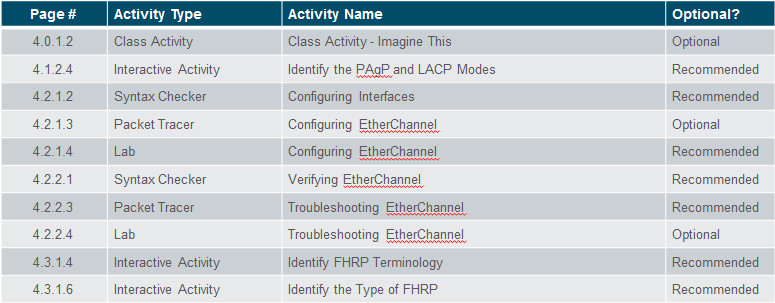

Assessment
Students should complete Chapter 4, “Assessment” after completing Chapter 4.
Quizzes, labs, Packet Tracers and other activities can be used to informally assess student progress.
Sections & Objectives
4.1 Link Aggregation Concepts
Explain link aggregation operation in a switched LAN environment.
Describe link aggregation.
Describe EtherChannel technology.
4.2 Link Aggregation Configuration
Implement link aggregation to improve performance on high-traffic switch links.
Configure link aggregation.
Troubleshoot a link aggregation implementation.
4.3 First Hop Redundancy Protocols
Implement HSRP
Explain the purpose and operation of first hop redundancy protocols.
Explain how HSRP operates.
Configure HSRP using Cisco IOS commands.
Troubleshoot HSRP.
Chapter 4: EtherChannel and HSRP
4.1 – Link Aggregation Concepts
4.1.1 – Link Aggregation
4.1.1.1 – Introduction to Link Aggregation
It is possible to combine the number of physical links between switches to increase the overall speed of switch-to-switch communication.
- STP will block redundant links to prevent routing loops.
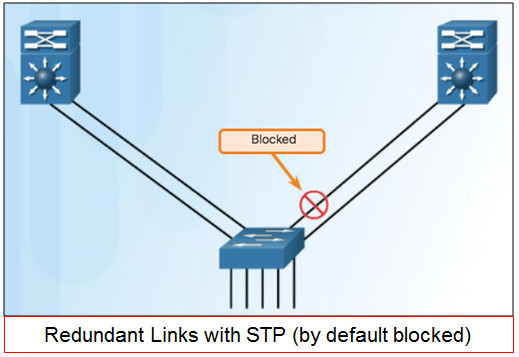
4.1.1.2 – Advantages of EtherChannel
Most configuration tasks can be done on the EtherChannel interface instead of on each individual port.
EtherChannel relies on existing switch ports.
Load balancing takes place between links that are part of the same EtherChannel.
EtherChannel creates an aggregation that is seen as one logical link.
EtherChannel provides redundancy because the overall link is seen as one logical connection.
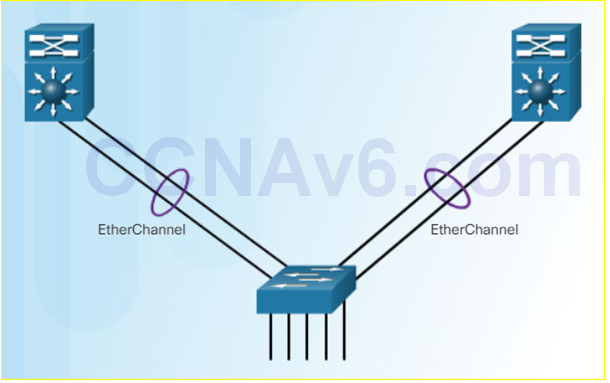
4.1.2 – EtherChannel Operation
4.1.2.1 – Implementation Restrictions
EtherChannel groups multiple physical ports into one or more logical EtherChannel links.
EtherChannel Restrictions
- Interface types cannot be mixed. (Fast Ethernet + Gigabit Ethernet cannot be grouped.)
- Provides full-duplex bandwidth up to 800 Mbps (Fast EtherChannel) or 8 Gbps (Gigabit EtherChannel)
- Cisco IOS Switch can support 6 EtherChannels.
- Created between two switches or a server and switch.
- If one side is configured as trunk, the other side must be a trunk within same native VLAN.
- Each EtherChannel has a logical port channel interface and changes to a channel affects its physical interfaces.
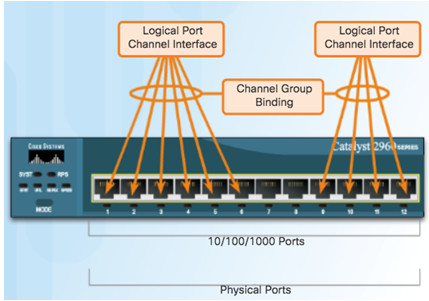
4.1.2.2 – Port Aggregation Protocol
EtherChannels can be formed by using PAgP or LACP protocol
PAgP (“Pag-P”) Cisco-proprietary protocol
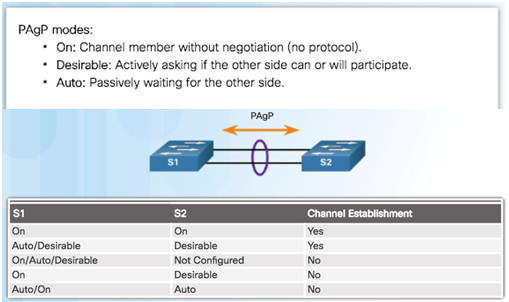
4.1.2.3 – Link Aggregation Control Protocol
LACP multivendor environment
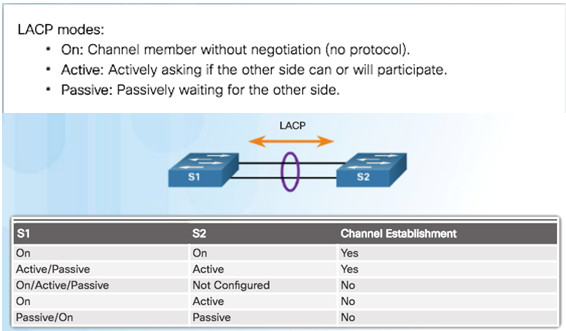
4.2 – Link Aggregation Configuration
4.2.1 – Configuring EtherChannel
4.2.1.1 – Configuration Guidelines
Configuration Settings Match on Both Switches
- Same speed and duplex mode.
- All interfaces in a bundle must be assigned to the same VLAN, or configured as a trunk.
- Trunk must support same range of VLANs.
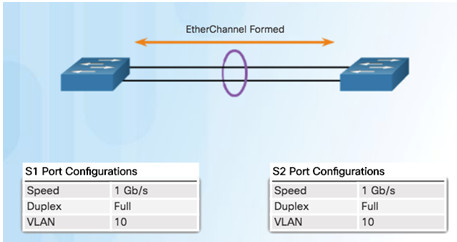
- If Configuration Settings Do Not Match
- EtherChannel not formed between S1 and S2
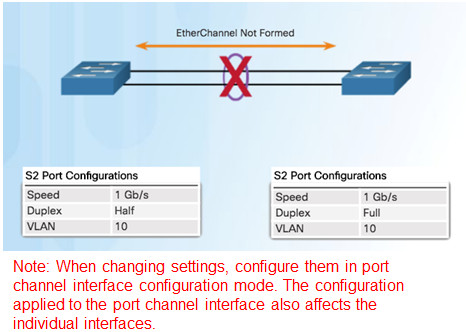
4.2.1.2 – Configuring Interfaces
This configuration creates EtherChannel with LACP and configures trunking.
- Step 1: Specify the interfaces that compose the EtherChannel group.
- Step 2: Create the port channel interface with the channel-group command in active mode. (Channel group number needs to be selected.)
- Step 3: Change Layer 2 settings in port channel interface configuration mode.

4.2.1.3 – Configuring EtherChannel
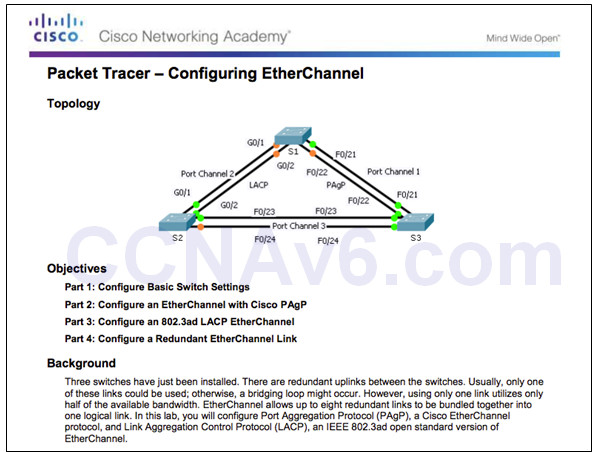
4.2.1.3 Packet Tracer – Configuring EtherChannel
4.2.1.4 – Configuring EtherChannel
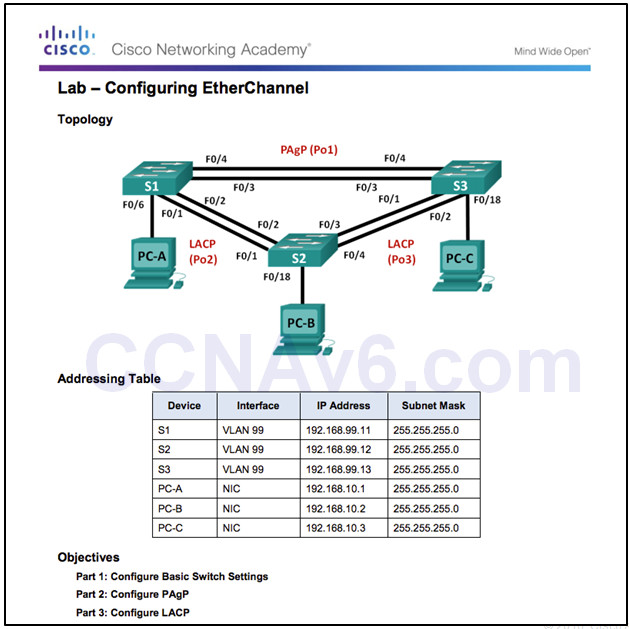
4.2.1.4 Lab – Configuring EtherChannel
4.2.2 – Verifying and Troubleshooting EtherChannel
4.2.2.1 – Verifying EtherChannel
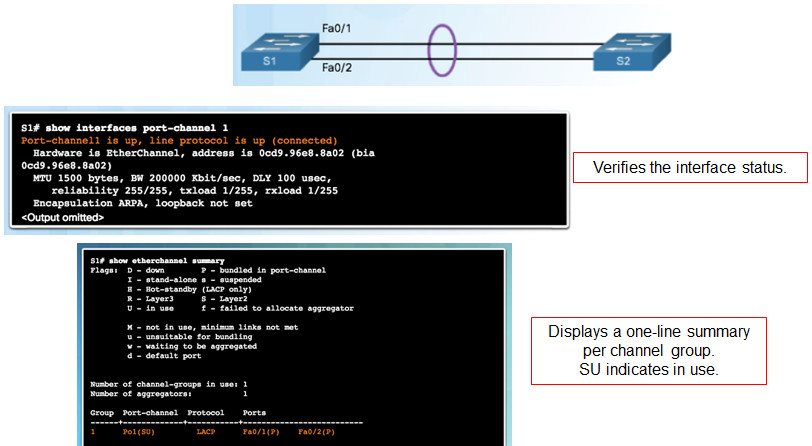
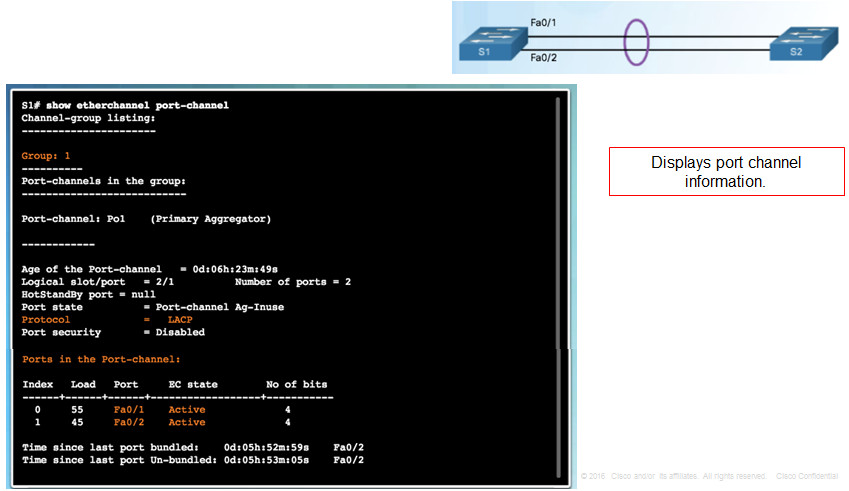
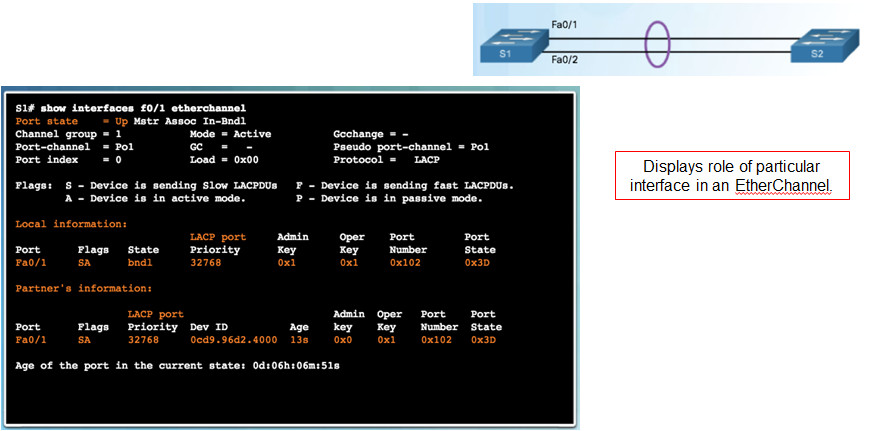
4.2.2.2 – Troubleshooting EtherChannel
All interfaces within EtherChannel must have the same:
- speed
- duplex mode
- native and allowed VLANs on trunk (Ports with different native VLANs cannot form an EtherChannel.)
- assigned to same VLAN


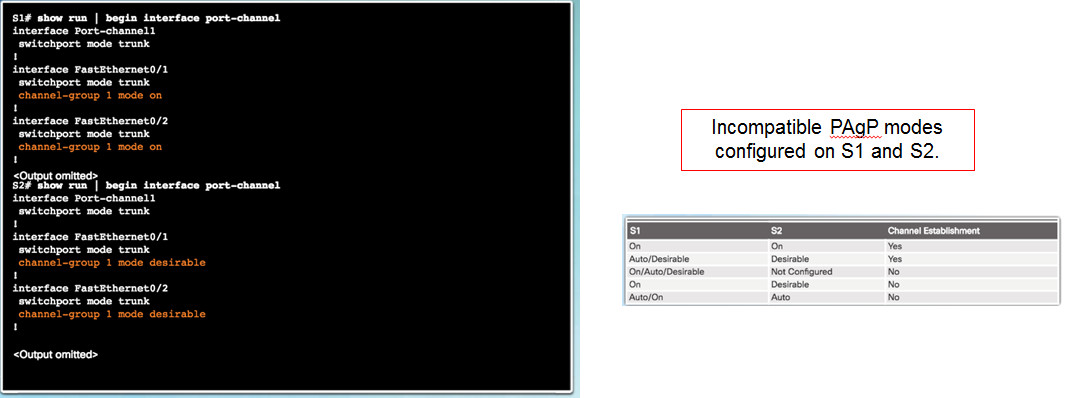
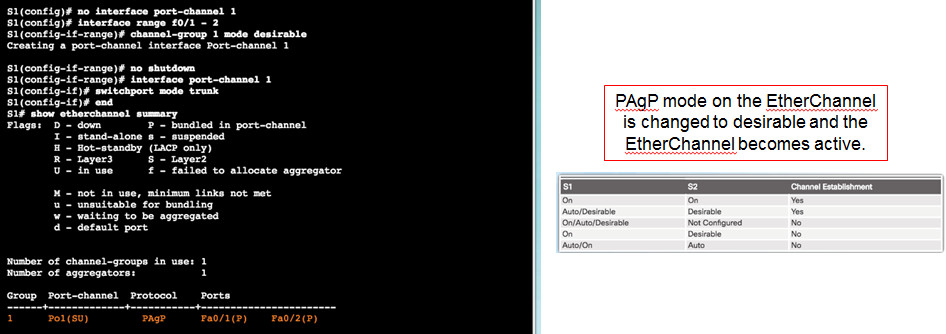
4.2.2.3 – Packet Tracer – Troubleshooting EtherChannel
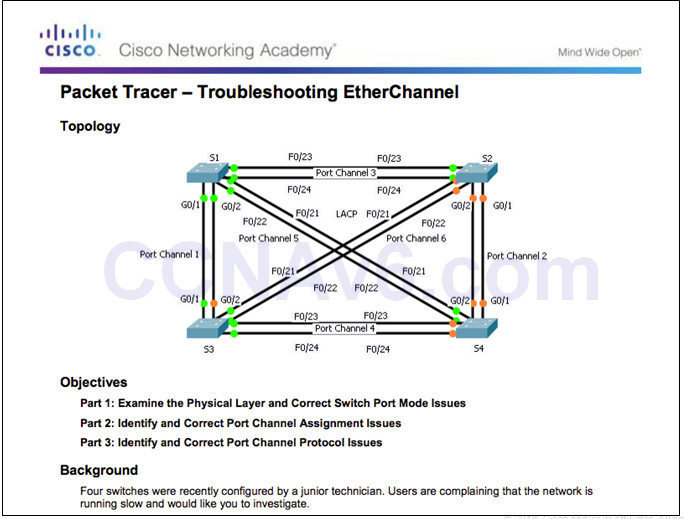
4.2.2.3 Packet Tracer – Troubleshooting EtherChannel
4.2.2.4 – Lab- Troubleshooting EtherChannel
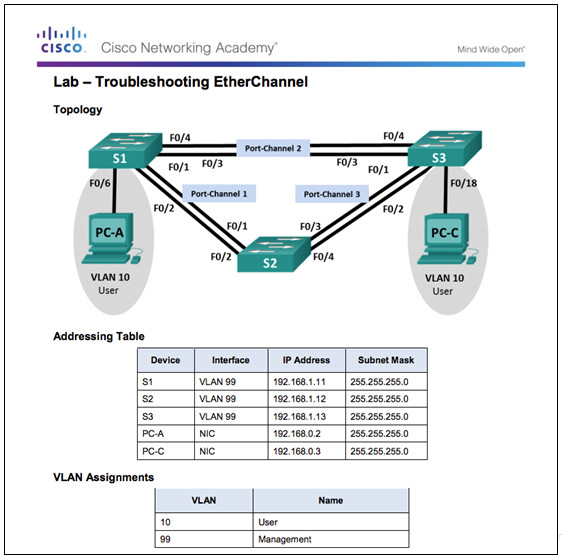
4.2.2.4 Lab – Troubleshooting EtherChannel
4.3 – First Hop Redundancy Protocols
4.3.1 – Concept of First Hop Redundancy Protocols
4.3.1.1 – Default Gateway Limitations
A mechanism is needed to provide alternate default gateways in switched networks where two or more routers are connected to the same VLANs.
- Note: In the graphic, a multilayer switch is acting as the default gateway and used for routing.
- In a switched network, each client receives only one default gateway.
- There is no way to use a secondary gateway, even if a second path exists to carry packets off the local segment.
- In the figure, R1 is responsible for routing packets from PC1. If R1 becomes unavailable, R2 can route packets that would have gone through R1.

- End devices are typically configured with a single IP address for a default gateway.
- If that default gateway IP address cannot be reached, the local device is unable to send packets off the local network.
4.3.1.2 – Router Redundancy
To prevent a single point of failure at the default gateway, implement a virtual router.
- Present the illusion of a single router to the hosts on the LAN.
- By sharing an IP address and a MAC address, two or more routers can act as a single virtual router.
- IPv4 address of the virtual router is configured as the default gateway for the workstations on a specific IPv4 segment.
- ARP resolution returns the MAC address of the virtual router.
- Physical router that forwards traffic is transparent to the host devices.

- A redundancy protocol provides the mechanism for determining which router should take the active role in forwarding traffic.
- Ability of a network to dynamically recover from the failure of a device acting as a default gateway is known as first-hop redundancy.
4.3.1.3 – Steps for Router Failover
When the active router fails, the redundancy protocol transitions the standby router to the new active router role.
These are the steps that take place when the active router fails:
- The standby router stops seeing hello messages from the forwarding router.
- The standby router assumes the role of the forwarding router.
- Because the new forwarding router assumes both the IPv4 and MAC addresses of the virtual router, the host devices see no disruption in service.
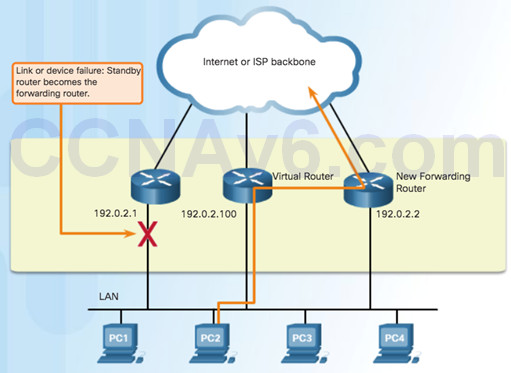
4.3.1.5 – First Hop Redundancy Protocols
Hot Standby Router Protocol (HSRP)– A Cisco-proprietary FHRP designed to allow for transparent failover of a first-hop IPv4 device.
- Active device is the device that is used for routing packets.
- Standby device is the device that takes over when the active device fails.
- Function of the HSRP standby router is to monitor the operational status of the HSRP group and to quickly assume packet-forwarding responsibility if the active router fails.
HSRP for IPv6 – Cisco-proprietary FHRP providing the same functionality of HSRP, but in an IPv6 environment.

Virtual Router Redundancy Protocol version 2 – A nonproprietary protocol that dynamically assigns responsibility for one or more virtual routers to the VRRP routers on an IPv4 LAN.
- One router is elected as the virtual router master, with the other routers acting as backups, in case the virtual router master fails.
VRRPv3– Capability to support IPv4 and IPv6.
Gateway Load Balancing Protocol (GLBP) – Cisco-proprietary FHRP that protects data traffic from a failed router or circuit allowing load balancing between a group of redundant routers.
GLBP for IPv6 – Cisco-proprietary FHRP providing the same functionality of GLBP.
4.3.2 – HSRP Operations
4.3.2.1 – HSRP Overview
One of the routers is selected by HSRP to be the active router and default gateway.
Other router will become the standby router.
If active router fails, standby assumes the role of active router and default gateway.
Hosts are configured with single default gateway VIRTUAL address that is recognizable by both the active and standby routers.
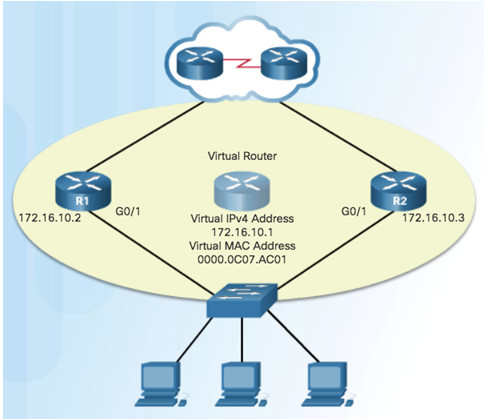
4.3.2.2 – HSRP Versions
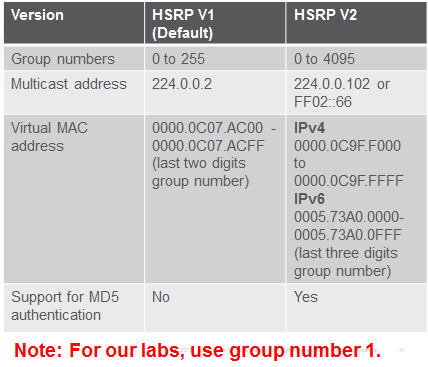
4.3.2.3 – HSRP Priority and Preemption
Role of active and standby routers determined by election process.
By default, the router with the numerically highest IPv4 address is elected as the active router.
Control HSRP election with priority and do not use highest address.
HSRP Priority
- Used to determine active router.
- Default HSRP priority is 100.
- Range is 0 to 255 and router with highest priority will become active.
- Use the standby priority interface command.
HSRP Preemption
- Preemption – ability of HSRP router to trigger the re-election process.
- To force a new HSRP election process, preemption must be enabled using standby preempt interface.
- A router that comes online with the a higher priority will become the active router.
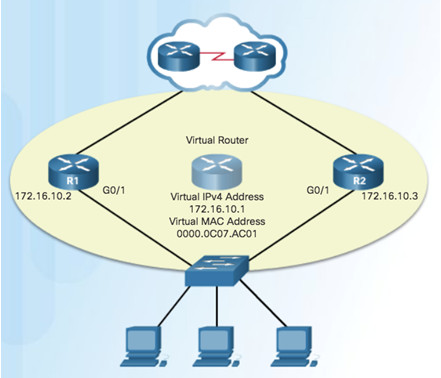
4.3.2.4 – HSRP States and Timers
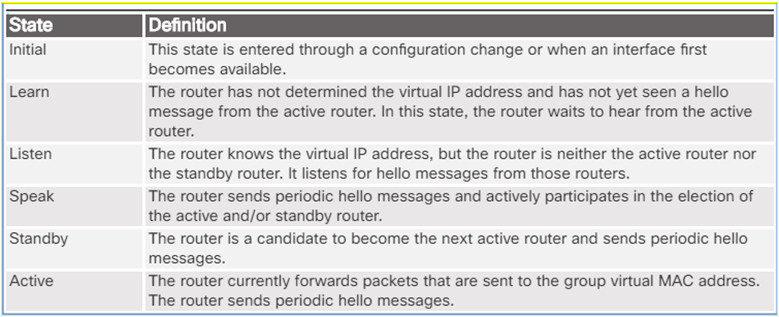
The active and standby HSRP routers send hello packets to the HSRP group multicast address every 3 seconds, by default. The standby router will become active if it does not receive a hello message from the active router after 10 seconds.
You can lower these timer settings to speed up the failover or preemption. However, to avoid increased CPU usage and unnecessary standby state changes, do not set the hello timer below 1 second or the hold timer below 4 seconds.
4.3.3 – HSRP Configuration
4.3.3.1 – HSRP Configuration Commands
Step 1. Configure HSRP version 2.
Step 2. Configure the virtual IP address for the group.
Step 3. Configure the priority for the desired active router to be greater than 100.
Step 4. Configure the active router to preempt the standby router in cases where the active router comes online after the standby router.
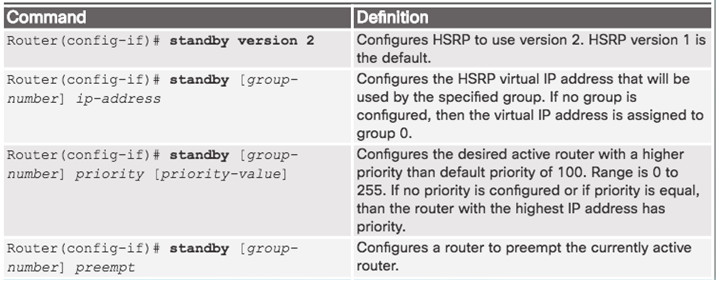
4.3.3.2 – HSRP Sample Configuration
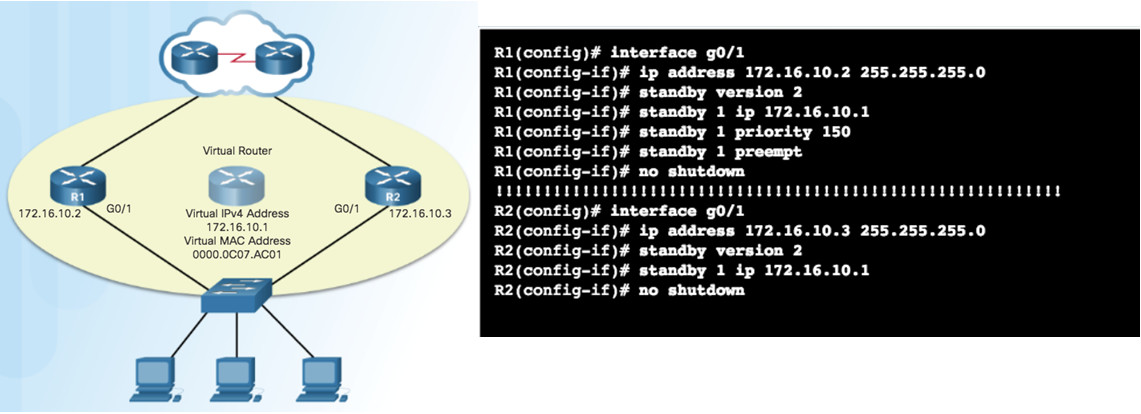
4.3.3.3 – HSRP Verification
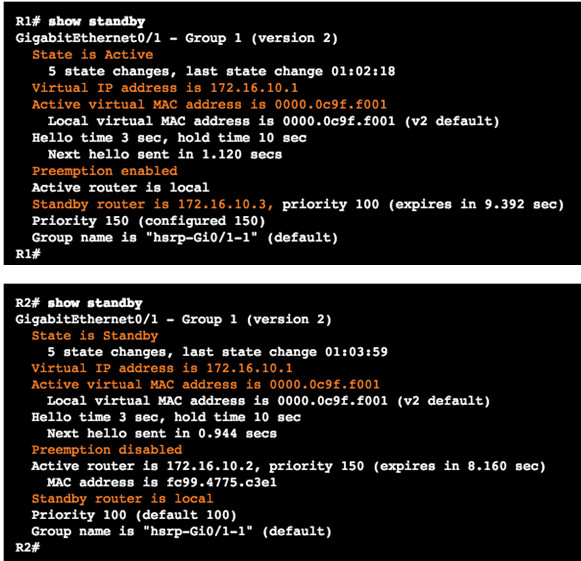
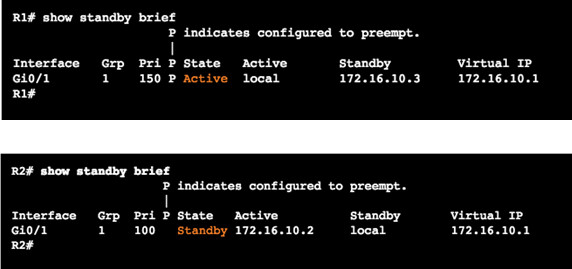
4.3.3.4 – Configure HSRP
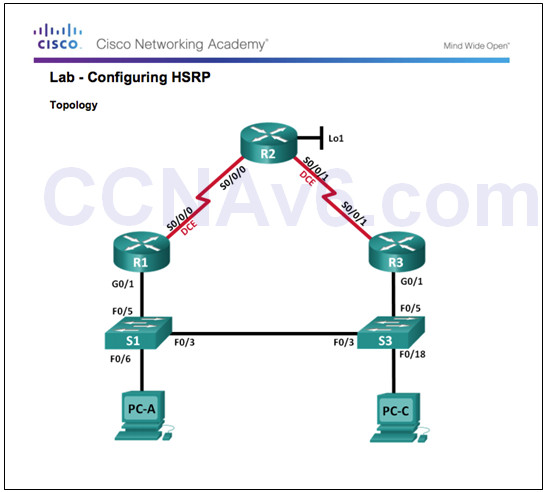
4.3.4 – HSRP Troubleshooting
4.3.4.1 – HSRP Failure
Most issues will arise during one of the following HSRP functions:
- Failing to successfully elect the active router that controls the virtual IP for the group
- Failure of the standby router to successfully keep track of the active router
- Failing to determine when control of the virtual IP for the group should be handed over to another router
- Failure of end devices to successfully configure the virtual IP address as the default gateway
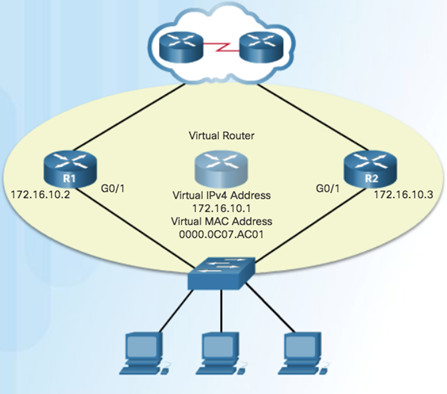
4.3.4.2 – HSRP Debug Commands
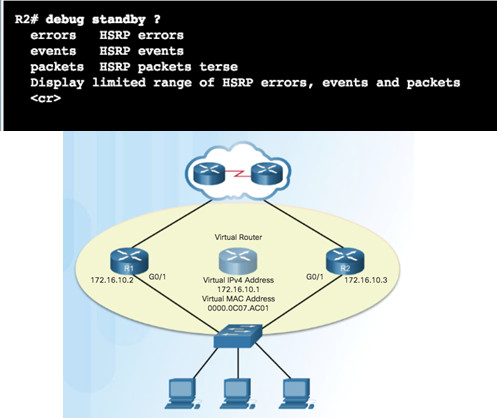

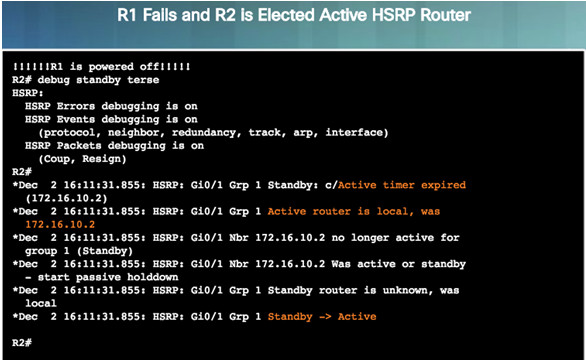
Use debug standby terse to view the HSRP events as R1 is powered down and R2 assumes the role of active HSRP router for the 172.16.10.0/24 network.
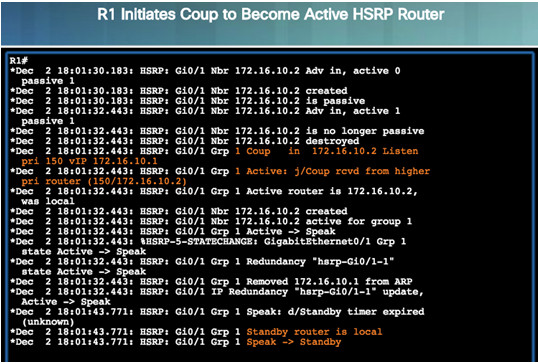
Because R1 is configured with the standby 1 preempt command, it initiates a coup and assumes the role of active router. R2 actively listens to hello messages during the Speak state until it confirms that R1 is the new active router and R2 is the new standby router.

4.3.4.3 – Common HSRP Configuration Issues
Use the debug commands to detect common configuration issues:
- HSRP routers are not connected to the same network segment. Although this could be a physical layer issue, it could also be a VLAN subinterface configuration issue.
- HSRP routers are not configured with IPv4 addresses from the same subnet. HSRP hello packets are local. They are not routed beyond the network segment. Therefore, a standby router would not know when the active router fails.
- HSRP routers are not configured with the same virtual IPv4 address. The virtual IPv4 address is the default gateway for end devices.
- HSRP routers are not configured with the same HSRP group number. This will cause each router to assume the active role.
- End devices are not configured with the correct default gateway address. Although not directly related to HSRP, configuring the DHCP server with one of the real IP addresses of the HSRP router would mean that end devices would only have connectivity to remote networks when that HSRP router is active.
4.3.4.4 – Troubleshoot HSRP
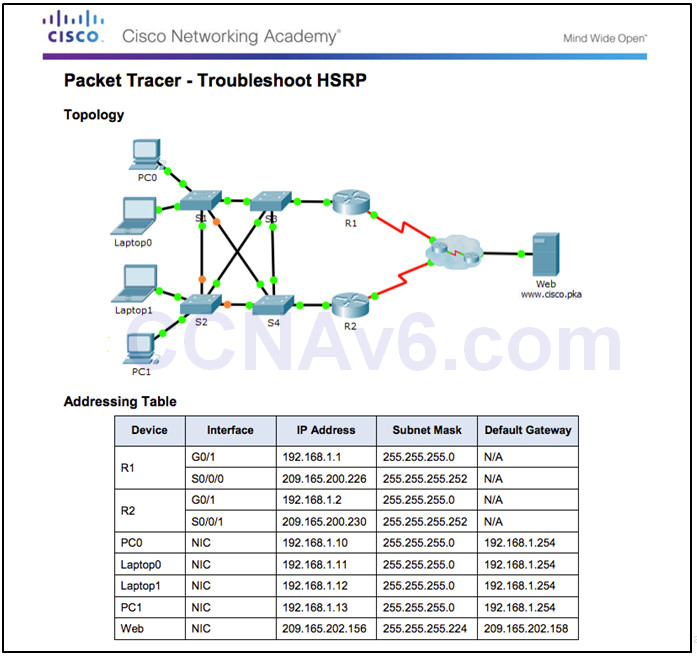
4.3.4.4 Packet Tracer – Troubleshoot HSRP
4.4 – Summary
4.4.1 – Summary
4.4.1.1 Linking Up Instructions
4.4.1.1 Linking Up Instructions
4.4.1.2 – Packet Tracer – Skills Integration Challenge
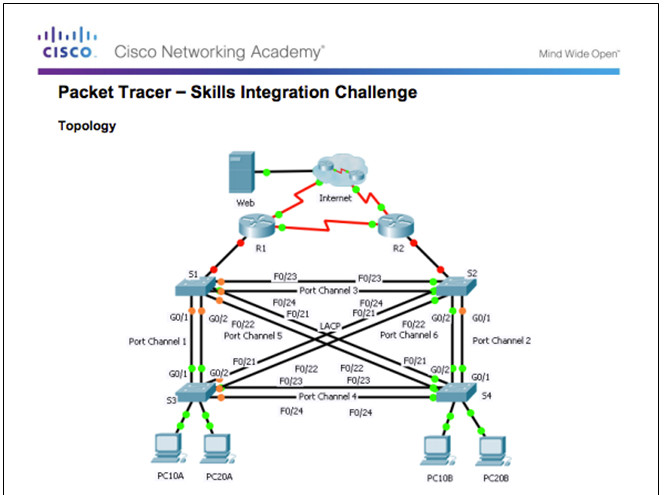
4.4.1.2 Packet Tracer – Skills Integration Challenge
4.4.2 – Conclusion
4.4.1.3 – Chapter 4: EtherChannel and HSRP
- Explain link aggregation operation in a switched LAN environment.
- Implement link aggregation to improve performance on high-traffic switch links.
- Implement HSRP.
New Terms and Commands
| •Port Aggregation Protocol (PAgP)
•IEEE 802.3ad |
•Link Aggregation Control Protocol (LACP) |
| •First Hop Redundancy Protocols (FHRP)
•Hot Standby Router Protocol (HSRP) •active router •standby router •Virtual Router Redundancy Protocol (VRRP) |
•ICMP Router Discovery Protocol (IRDP)
•master router •backup router •Gateway Load Balancing Protocol (GLBP) |
